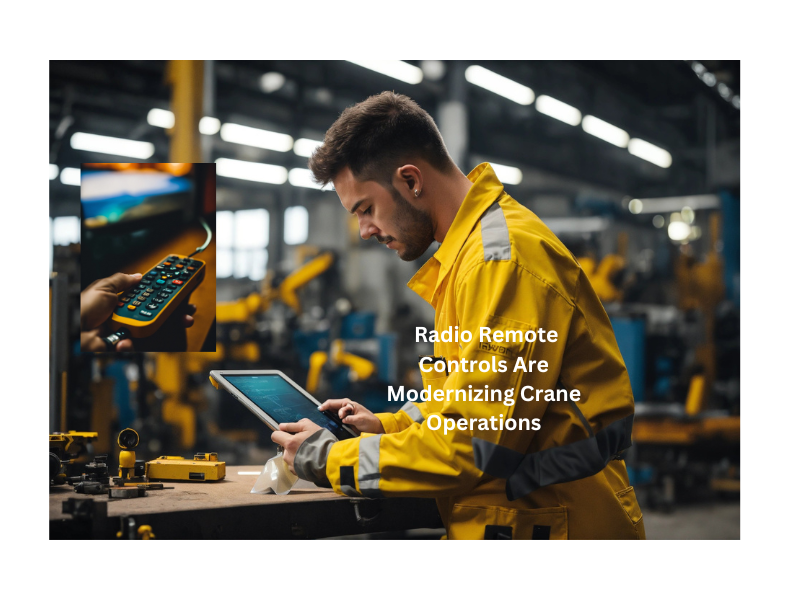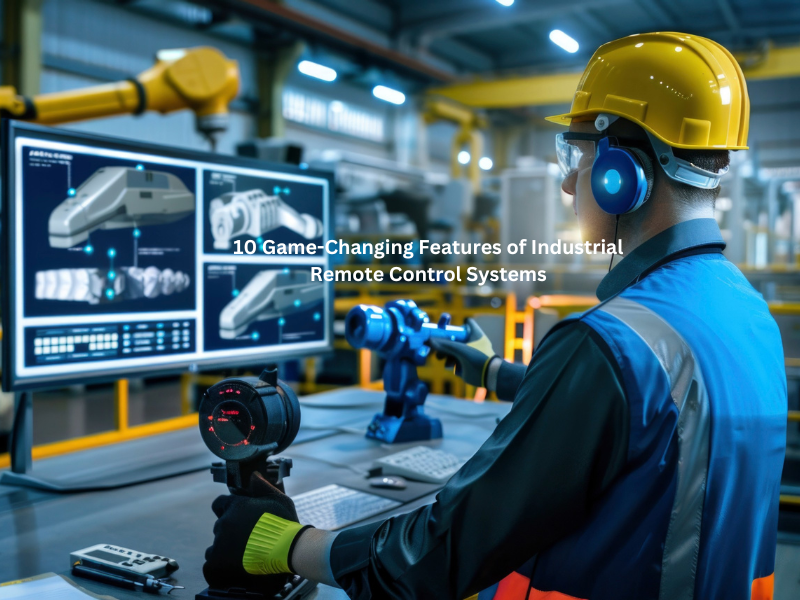Introduction: Overview of Crane Control Options
In the dynamic world of construction, where efficiency and safety are paramount, the debate over wireless vs wired crane controls has become a pivotal topic among industry professionals. Imagine a bustling site where towering cranes orchestrate the dance of heavy materials with precision—now consider how their control systems influence this intricate ballet.
With technological advancements revolutionizing equipment operation, choosing between traditional wired controls and modern wireless systems can significantly impact productivity and operational safety.
As construction projects grow in complexity and scale, so too do the demands on crane operators who rely on these control systems to maneuver massive loads with confidence. Wired controls offer reliability and reduced interference but come with limitations in mobility and flexibility.
On the other hand, wireless controls promise enhanced freedom of movement but raise concerns about signal integrity and battery life. In this article, we will explore both options’ advantages and disadvantages to help you make an informed decision for your construction site’s unique needs.
Definition: What is Wireless Crane Control?
Wireless crane control refers to the use of advanced technology to operate cranes without the need for physical tethering, providing operators with enhanced mobility and flexibility. This system typically involves a radio frequency or Bluetooth-enabled remote control that relays commands from a user directly to the crane’s control unit. By eliminating cumbersome cables, operators can move freely around the worksite, gaining a broader perspective of their environment and improving safety during operations.
Beyond mere convenience, wireless crane control significantly enhances operational efficiency. It allows multiple cranes to be coordinated seamlessly from a single point of command, reducing downtime and optimizing workflow on complex projects.
Additionally, modern systems often integrate real-time data feedback mechanisms that provide insights into load monitoring and equipment performance, enabling proactive maintenance and reducing the risk of accidents or failures. As industries continue to embrace automation and smart technology, wireless crane control stands out as an essential tool for improving productivity while ensuring safe lifting practices in diverse environments.
Definition: What is Wired Crane Control?
Wired crane control refers to the system that allows operators to directly manage the movements and operations of cranes through a set of cables or wires, rather than relying on wireless technologies.
This control mechanism is integral to ensuring precision in heavy lifting tasks, where even slight errors can lead to significant safety hazards or operational inefficiencies. Wired systems are often prioritized in environments where signal interference might occur, ensuring reliability and consistent performance.
One compelling aspect of wired crane control is its ability to enhance safety protocols within industrial settings. Since wired systems provide uninterrupted communication between operator and machine, they significantly reduce the chances of miscommunication or delays that could lead to accidents.
Additionally, the physical connection helps maintain stability during operation, allowing operators to respond swiftly to changing conditions—whether it’s adapting movement based on environmental factors or managing complex load placements with heightened accuracy.
Moreover, advancements in technology have transformed traditional wired crane controls into sophisticated systems enriched with real-time data analytics.
These innovations enable operators not only to execute maneuvers seamlessly but also monitor performance metrics and machinery status continuously. By embracing this blend of time-tested methods and modern improvements, industries can achieve a higher degree of efficiency while cultivating safer working environments for all personnel involved.
Advantages of Wireless Crane Controls
One of the key advantages of wireless crane controls is enhanced operator mobility. Traditional wired systems often tether operators to specific locations, limiting their visibility and situational awareness during lifting operations.
Wireless technology allows operators to move freely around the worksite, facilitating better communication with ground personnel and promoting safer operations. This increased agility not only enhances productivity but also minimizes the risk of accidents caused by obstructed views or miscommunications.
Another significant benefit is the reduction in setup time and complexity. With fewer cables and wires to manage, implementing wireless crane controls simplifies installation processes, leading to faster deployment in various environments—from construction sites to warehouses.
Furthermore, these systems often come equipped with advanced features such as remote diagnostics and real-time data monitoring. This enables proactive maintenance strategies that can detect issues before they escalate into costly repairs or operational downtime, ultimately extending equipment lifespan and enhancing overall efficiency in material handling operations.
Advantages of Wired Crane Controls
Wired crane controls offer a significant advantage in terms of reliability and stability during operation. Unlike their wireless counterparts, wired systems are less prone to interference from environmental factors such as electromagnetic noise, ensuring consistent performance in demanding industrial settings. This reliability is critical when lifting heavy loads or performing intricate maneuvers, where even the slightest delay or signal loss can pose serious safety risks.
Moreover, wired crane controls often come with enhanced security features that protect against unauthorized access and accidental operations. The physical connection not only minimizes the risk of hacking—an increasing concern in an era dominated by wireless technology—but also simplifies troubleshooting and maintenance.
With direct connections, operators can quickly identify faults and perform repairs without navigating complex network issues typically associated with wireless systems. Ultimately, for facilities prioritizing safety and efficiency, investing in wired crane controls can lead to safer work environments and minimized downtime.
Key Considerations for Choosing Control Type
When selecting a control type, understanding the context of use is paramount. Consider whether the application requires precision or adaptability; for example, industrial automation may benefit from a PID controller’s fine-tuning capabilities, while user-oriented systems might favor fuzzy logic controllers for their ability to accommodate variability in human inputs. Each control type operates under different principles that can significantly affect overall performance and user experience.
Cost-effectiveness also plays a crucial role in decision-making. While advanced control systems like Model Predictive Control (MPC) offer unparalleled performance in complex environments, their implementation and maintenance can be resource-intensive.
Evaluating the total cost of ownership—factoring in both initial investments and operational longevity—can guide you toward a more sustainable choice that balances performance needs with budget constraints.
Moreover, scalability should not be overlooked as businesses evolve. A control system must be flexible enough to adapt to future demands without requiring complete overhauls. This foresight ensures not only seamless integration with existing infrastructure but also paves the way for innovations down the line, protecting your investment against obsolescence as technology continues to progress.
Safety Features in Wireless vs. Wired Systems
When comparing safety features in wireless and wired systems, it’s important to recognize that each has distinct advantages. Wired systems often provide a sense of reliability due to their physical connections, which are less susceptible to interference.
This stability is crucial in environments where consistent data transmission is paramount, such as hospitals or financial institutions. The inherent nature of wired systems also makes them more difficult for unauthorized users to access remotely, enhancing security against hacking and cyber threats.
On the other hand, wireless systems are rapidly advancing with sophisticated encryption protocols and frequent updates aimed at fortifying security measures. Technologies like Mesh networking can significantly enhance coverage while reducing vulnerability; if one node fails or is compromised, others can maintain connectivity without a security breach.
Additionally, the flexibility of wireless setups allows for real-time monitoring capabilities that can quickly identify and respond to anomalies—providing a proactive layer of safety that traditional wired systems may lack. As both technologies evolve, striking a balance between accessibility and security will be key in determining which system best meets an organization’s unique safety needs.
Cost Comparison: Wireless vs. Wired Controls
When evaluating the cost comparison between wireless and wired controls, it’s essential to consider both initial investment and long-term expenses. Wireless systems often come with a higher upfront price tag due to more advanced technology and components like transmitters and receivers.
However, these systems can save money on installation since they eliminate the need for extensive wiring—reducing labor costs significantly. This makes wireless options particularly appealing for retrofitting older buildings where running new wires would be both disruptive and expensive.
On the other hand, wired controls tend to offer lower ongoing maintenance costs over time; once installed, they typically require less frequent servicing compared to their wireless counterparts that may suffer from signal interference or battery depletion issues.
Additionally, wired controls often provide stronger reliability in environments prone to RF interference or heavy machinery operation. Therefore, while wireless solutions might attract budget-conscious buyers up front through easier installations, savvy consumers should weigh potential hidden costs against the robustness of wired systems for a truly informed decision in their cost comparison analysis.
User Experience and Operator Preference
User experience (UX) is a pivotal factor in shaping operator preference, ultimately influencing the efficiency and satisfaction of those who interact with complex systems. When operators encounter intuitive interfaces that prioritize their needs and workflows, they are more likely to develop a sense of ownership and loyalty towards the system.
This alignment between UX design and operator tasks ensures smoother operations, reduces training time, and fosters greater engagement as users feel empowered rather than overwhelmed.
Furthermore, understanding the nuances of operator behavior can lead to innovations that enhance both user experience and overall productivity. For instance, incorporating feedback mechanisms that allow operators to suggest improvements creates a participatory culture where users feel their opinions matter.
Such inclusion not only refines system functionality but also builds trust and confidence among staff. As companies increasingly recognize these dynamics, leveraging data analytics to tailor experiences based on individual preferences becomes essential—transforming what once was a passive interaction into an active partnership between user interface design and operational excellence.
Conclusion: Making the Right Choice for Your Site
In conclusion, selecting the right tools and strategies for your site is crucial to its success and user experience. By carefully evaluating your options based on functionality, design, and scalability, you can ensure that your website meets both current needs and future growth potential.
Additionally, considering factors such as target audience and industry trends will further enhance the relevance and engagement of your content. Ultimately, making informed decisions now will save time and resources down the line. Take the time to analyze your choices thoroughly—your site’s performance depends on it!





